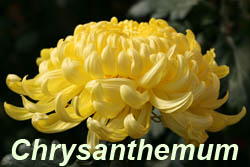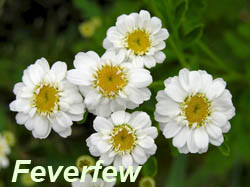Herb Garden
The joy of growing and using herbs
by Rachel McLeod
Chrysanthemums
 The fall is the time of year when we enjoy chrysanthemums in the garden. These showy flowers in their glowing colors and different shapes, from simple daisy flowers to huge fluffy balls come originally from China where they have been used medicinally for centuries. Here they are used for fall color in the garden and are not thought of as herbs. However there are some modest members of the family that many of us would not recognize as chrysanthemum but which are candidates for the herb garden and should be included in any collection of useful plants. The fall is the time of year when we enjoy chrysanthemums in the garden. These showy flowers in their glowing colors and different shapes, from simple daisy flowers to huge fluffy balls come originally from China where they have been used medicinally for centuries. Here they are used for fall color in the garden and are not thought of as herbs. However there are some modest members of the family that many of us would not recognize as chrysanthemum but which are candidates for the herb garden and should be included in any collection of useful plants.
The first is Chrysanthemum cinerariifolium, more commonly known as Pyrethrum. This is a grey leafed plant with small white daisy flowers. The flower buds are collected as they open and then dried. They are the basis of many botanical insecticides and contain a chemical which paralyses and poisons insects but does not affect mammals. However such insecticides should be used with great care as they will affect beneficial insects such as honey bees and ladybugs. This pyrethrum is not winter hardy in our area.
A closely related species, Chrysanthemum coccineum (also called pyrethrum), is the Painted Daisy which has cheerful red and pink daisy flowers in early summer. This has been hybridized to give us a lovely border plant and it makes a colorful patch in the herb garden. Its flower buds are not really worth collecting for a homemade insecticide as they do not have very strong insecticidal properties. To grow well it needs a well drained sunny position in light sandy soil.
Chrysanthemum balsamita has many common names: Alecost because it was used in the Middle ages to flavor beer; Bibleleaf because its sweet smelling minty leaves were pressed and used as bookmarks in Bibles and as a refreshing scent if the services were too long and tedious. A third name is Costmary. This is probably the one most used and it combines an earlier French name, Herbe Sainte- Marie, with the plant's origin. Costus means oriental plant and Costmary was introduced from the Orient.
Costmary grows in any well drained soil and it does not need rich soil or any mulching. It grows a meter or more tall and produces flower buds in late summer. However these never amount to much and it is probably best to keep the plant cut back so that it produces young stems with fresh green leaves which can be used to give a minty flavor to dishes or to make a delicious tea and when dried are useful in pot-pourri or perhaps as bookmarks.
 Finally, Feverfew – Chrysanthemum parthenium – is probably the best known of the herbal Chrysanthemums. Its bright little daisy flowers and yellow green foliage with a pungent aroma brighten herb gardens. It self-seeds prolifically, which is useful as the plant grows up to a meter tall and is bushy. Gradually the older stems become woody and it is best to discard such plants and let the younger seedlings take over. I have found this a wonderful colonizing plant. In the sterile, dry soil left by builders and under the overhang of a newly built home it looked as though nothing could grow; but Feverfew seeded itself in the area and within a year had broken up the soil and colonized the whole strip making it ready for more fussy plants. Finally, Feverfew – Chrysanthemum parthenium – is probably the best known of the herbal Chrysanthemums. Its bright little daisy flowers and yellow green foliage with a pungent aroma brighten herb gardens. It self-seeds prolifically, which is useful as the plant grows up to a meter tall and is bushy. Gradually the older stems become woody and it is best to discard such plants and let the younger seedlings take over. I have found this a wonderful colonizing plant. In the sterile, dry soil left by builders and under the overhang of a newly built home it looked as though nothing could grow; but Feverfew seeded itself in the area and within a year had broken up the soil and colonized the whole strip making it ready for more fussy plants.
As well as the abundance of flowers, the foliage stays green all winter. For all these reasons feverfew could be called an ideal garden plant except that it self-seeds so readily that it would be considered a weed by many gardeners. However I would not like to be without it; it is easy to pull out if it seeds in the wrong place and it often chooses to brighten a difficult area.
There are two varieties which are attractive in the garden and not as prolific. One is a double flowered form and and the other has golden leaves. Both are worth searching out.
The plant has a very strong and bitter odor...it is not a sweet smelling herb! but the aroma may deter insects and it can be useful as a dried herb in moth bag mixtures. Feverfew has also been known for a variety of medicinal qualities, maybe because of its strong and antiseptic odor. It has been used as a tonic, particularly for women, as a relief for the pain and itching of insect bites and many years ago at a well known herb garden in France I found they were growing feverfew as a substitute for chamomile flowers.
More recently, some sufferers of migraine headaches have found relief by regularly eating a leaf in a sandwich a day. But like all home remedies this should be tried out with the greatest caution.
Rachel McLeod founded Kiln Farm Herb Garden in Puslinch, Ontario in 1974.
|

